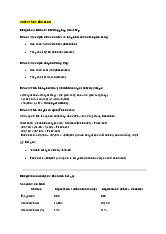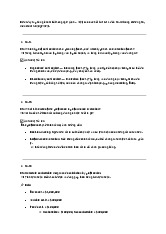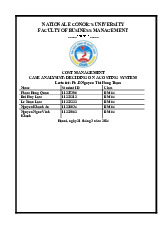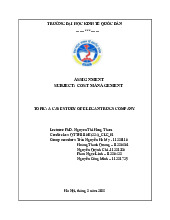










Preview text:
lOMoAR cPSD| 58511332
NATIONAL ECONOMICS UNIVERSITY
SOCIALIST REPUBLIC OF VIETNAM
CENTER FOR ADVANCED EDUCATIONAL
Independence – Freedom – Happiness PROGRAMS SYLLABUS 1. GENERAL INFORMATION Title: COST MANAGEMENT
Course number: CLC- QTTH1116 E
Specialized Education Course
Number of Credit: 3 (48 lecture hours include reviewing time) - Theoretical hours: 27 - Discussion hours: 18 Prerequisite: Microeconomics 1
2. LECTURER’S INFORMATION
Full name: Nguyen Thi Hong Tham Title: PhD
Address: Room 1008, 10th floor, Building A1, National Economics University, 207 Giai Phong
Road, Hai Ba Trung District, Hanoi, Vietnam. Phone number: 0916126019 Email: thamnth@neu.edu.vn
Faculty/ Institute: Faculty of Business Management 3. COURSE DESCRIPTIONS
Cost management is a course that helps learners know how to collect, process and adjust
economic information inside an enterprise to serve as a basis for business management
decisions and cost control in the enterprise.
4. LEARNING RESOURCES: COURSE BOOKS, REFERENCE BOOKS, AND SOFTWARE Course Book:
[1] Edward Blocher, David Stout, Paul Juras, Gary Cokins (2012). Cost Management: A
Strategic Emphasis, 6th Edition, Publisher: McGraw-Hill Education.Ronald Hilton, Reference Books:
[2] Michael Maher, Frank Selto (2004). Cost Management: Strategies for Business
Decisions, 3rd edition, Publisher McGraw-Hill/Irwin
[3] Charles T. Horngren, George Foster, Srikant M. Datar, Madhav V. Rajan (2008). Cost
Accounting: A Managerial Emphasis, 13th Edition, Prentice Hall
[4] Nguyen Ngoc Huyen (2020). Giáo trình: Tính Chi Phí Kinh Doanh (Cost
Management). National Economics Uninersity lOMoAR cPSD| 58511332 5. COURSE GOALS Program Capability Goal Goal Description Learning Level Outcomes (PLO) [1] [2] [3] [4]
G1 Have knowledge of business cost and business PLO1 Understanding
costing according to the purpose of the Applying
manager. Gathering business costs incurred at Evaluating
the level of the whole enterprise as well as the
internal departments of the business. Manage
business expenses by month, week, day, shift
and up to each hour of operation.
Basic concepts of cost, expenditure, business
cost and financial cost; distinguish the
difference between business cost and financial
expenses to recognize the objective necessity
as well as the nature and tasks of calculating
and managing business cost in the enterprise
for the purposes of business administration and cost control.
Calculating business cost incurred by type at
the enterprise level, forming cost centers from
the enterprise level to the lowest level
(workplace) indirect cost allocating at each cost center
Calculating variable cost as well as fixed cost
as required when making business decisions.
Using business cost information to make
administrative decisions, control and manage
business costs in the enterprise.
G2 Have the basic skills of costing and managing PLO1 Understanding
business costs in enterprises for business Applying
administration and cost control purposes. Evaluating Have independent working skills,
communication skills and the art of
calculating business costs and controlling costs in businesses. lOMoAR cPSD| 58511332
Teamwork skills are also trained to coordinate
the implementation of cost control and
business administration, solving cost issues
arising in the business. On that basis, apply
flexibly synthetic, analysis skills and solve
practical problems in cost management.
G3 Students will be able to demonstrate PLO6 Understanding
interpersonal skills for working in a dynamic Applying
and diverse world, including in a team environment. Evaluating
G4 Students will be able to demonstrate effective PLO5 Understanding
written and oral communication skills in Applying English. Evaluating
6. COURSE LEARNING OUTCOMES (CLO) Goal Course CLO Description Capability Learning Level Outcomes (CLO) [1] [2] [3] [4] PLO 1 CLO.1.1
The necessary basic knowledge about Understanding
business cost, business cost management, Applying
business costing, business costing principles
and the difference between the business Evaluating costing and finacial costing. CLO.1.2
Recognize the basic concepts and contents of Understanding
the types of costs in the business, allocate Applying
indirect costs, set up cost centers, center and product costing Evaluating CLO.1.3
Recognize the basic concepts and contents of Understanding
using information to make management Applying
decisions and cost control in the enterprise to Evaluating
realize the strategic goals of the business. CLO.1.4
Recognize the basic concepts and contents of Understanding
cost analysis in decision-making and cost Applying
control in the enterprise to realize the strategic goals of the business. Evaluating CLO.1.5
Solve specific situations of cost problems Understanding
arising in enterprises, provide possible lOMoAR cPSD| 58511332
solutions for analysis and control of business Applying costs Evaluating CLO.1.6
Apply knowledge to solve problems in Understanding
business cost management in different Applying departments, industries and fields:
production, trade, service, tourism, hotel... Evaluating PLO 5 CLO.5.1
Foreign language skills, understanding and Understanding
writing basic articles and reports on business Applying topics Evaluating CLO.5.3
Students have communication skills through Understanding
group exercises and presentations Applying Evaluating CLO.5.3
Demonstrate effective written and oral Applying
communication skills in English CLO.5.4
Communicate professionally in business Applying
situations and working environment PLO6 CLO.6.1
Students have dynamic and diverse Understanding teamwork skills Applying Evaluating CLO 6.2
Facilitates the Contributions of Team Apply Members CLO6.3
Demonstrate interpersonal skills for working Apply in a team environment CLO.6.4
Students have the ability to work Apply
independently as well as contribute to team
meetings, have the ability to plan, implement,
coordinate, evaluate and improve professional
activities to do business cost management in
enterprises, control costs and use cost information to make decisions 7. COURSE ASSESSMENT Type of Content Week CLO
Criteria for assessment Prop. Assessment (%) [1] [2] [3] [4] [5] [6] lOMoAR cPSD| 58511332 Participation
1-15 CLO1.1-- Full attendance, be present on time. 10% Assessment 1.5,
Attitude: positive, active, highly CLO5.16.4 interactive. -
Quality of the discussion in the
class: answer accurately and focus
on the subjects discussed; scientific,
logical, clear, and persuasive.
Mid-term Chapters 10 CLO1.1.-1.3 Class test or writing assignment, 20% assessment 1-6
testing the understanding of cost - management.
The evaluation method depends on
the correct answer and focuses on
the subject, scientific argument, logic, clear, and persuasive. Group Chapters 12-15 CLO1.1,
Discussion and analysis of incurred 20% presentation 1-6 CLO1.4-
business costs and calculation 1.5, methods
CLO2.1-- Lecture in class, answering 2.5,
questions from the lecturer and
CLO 3.1-- other groups; Evaluation of 3.2
presentation: creative, lively, CLO.5.1
effective, full members of the group CLO.5.3- to participate; CLO.5.3
Evaluation of the quality of group CLO.5.4
work, persuasive presentation, CLO.6.4
practical inquiry with a suitable CLO.6.1
attitude, grasping the problem of CLO 6.2
enterprises and give a possible and CLO6.3 feasible solution. -
Assessment of the quality of the
presentation and the response to the
criticism: the correct answer and
focus on the issue being discussed,
scientific, logical, clear and convincing. lOMoAR cPSD| 58511332
Final-term Chapters After CLO 1.1-- The essay in the examination room, 50% Assessment 1-6 week 1.5,
including multiple choice questions, 15
theoretical questions and brief case studies.
- The quality of the answers: accurate
answers and focus on questions;
scientific arguments, logic, clarity, and persuasiveness. 8. LESSON PLAN Week Content CLO Activities Assessmen t [1] [2] [3] [4] [5] lOMoAR cPSD| 58511332 1
Chapter 1: Introduction to business cost CLO.1.1, Lecturers: Multiple and cost management CLO.1.2, - Introduction choice
1.1 Financial cost and business cost CLO.1.3, of the course, questions
1.2 Managing business costs in the detailed outline, enterprise study materials,
1.3 General business costing issues reference 1.4. Nature of business cost materials, exam management regulations, class
1.5 Principles of business cost regulations, test management and assessment - Build study groups, assign tasks to groups, make work plans for groups - Lecture and explain the subject, scope, and objectives of the course - Answer student questions Student - Studying study materials - Group division - Reply to the discussion
Chapter 2: Basic cost management CLO.1.1, Lecturers Multiple
concepts and Job Costing CLO.1.2, - Introduction of choice
2.1 Classification of business costs CLO.1.4, chapters, study questions materials, Group work 2-3 2.2 Period and Job Costing CLO.1.5 lOMoAR cPSD| 58511332 CLO.5.1 references - CLO.5.3 Preaching and CLO.5.3 explaining - CLO.5.4 Discuss case CLO.6.4 scenarios and CLO.6.1 lecture content CLO 6.2 in class CLO6.3 - Answer student questions Student - Studying study materials - Reply to the discussion 4-5
Chapter 3: Cost allocation, cost CLO.1.1, Lecturers Multiple
center and product costing CLO.1.2, - Presenting choice
3.1 Allocation of indirect costs CLO.1.3, and explaining - questions 3.2 Costing in cost center CLO.1.4, Discuss case 3.3 Product Costing CLO.1.5 scenarios and lecture content in class - Correction of costing exercises - Answer student questions Student - Studying study materials - Presenting group exercises related to the content of the chapter - Reply to discussion 6-7
Chapter 4: Making business CLO.1.2, Lecturers Multiple
decisions based on cost information CLO.1.3, - Lecture choice 4.1 Duties of business cost CLO.1.4, content and questions management CLO.1.5 explanation - Instructions for
4.2. Cost analysis and strategic doing correction analysis in decision making exercises lOMoAR cPSD| 58511332 - Answer students' questions Student - Researching documents - Prepare questionsand answers - Practice exercises, correct homework 8-9
Chapter 5: Business cost planning CLO.1.4, Lecturers Multiple and controlling CLO.1.5 - Lecture choice
5.1. Cost, profits and budgets planning CLO.5.1 content and questions Group 5.2. Controlling CLO.5.3 explanation - discussion 5.3.Reducing operation cost CLO.5.3 Instructions for CLO.5.4 doing correction CLO.6.4 exercises CLO.6.1 - Answer CLO 6.2 students' questions CLO6.3 Student - Researching documents - Prepare questionsand answers - Practice exercises, correct homework lOMoAR cPSD| 58511332
10-11 Chapter 6: Cost control and CLO.1.4, Lecturers Multiple
managers’ responsibilities 6.1. CLO.1.5 - Lecture choice Strategic performance content and questions Discussion measurement and assessment explanation -
of managers’ responsibilities Instructions for 6.2. Waste and fraud doing discussion
6.3. Controlling business costs and exercises, management responsibility correcting essays - Answer students' questions - Exam week 11 Student - Researching documents - Prepare questions and answers Practice exercises, correct homework
12-15 Group presentation CLO.1.1, Lecturers Group Q&A CLO.1.2, - Listen to exercises Test CLO.1.3, students' CLO.1.4, presentations CLO.1.5 - Score CLO.5.1 announcement CLO.5.3 Student - Group CLO.5.3 presentation - CLO.5.4 Listen to suggestions, CLO.6.4 answer questions CLO.6.1 CLO. 6.2 CLO. 6.3
9. COURSE REQUIREMENTS AND EXPECTATION
9.1. Attendance Requirements
- Students are required to fully take part in class lectures and activities.
- Students are allowed to be absent a maximum of 20% of the class hours. Students who
are absent over 20% are not qualified to take the final exam.
9.2. In-class Behaviour Requirements lOMoAR cPSD| 58511332
- The course is carried out with respect to both lecturer and students. All behaviors that
might adversely affect the stakeholders are prohibited.
- Students need to be in class on time. Students being late for more than 10 minutes will
not be eligible to take part in the session.
- Cellphones, laptops, and tablets are only accepted for the purposes of taking notes of
the lectures, and preparing course assignments, not for any other entertainment purposes.
- Students will be asked to rank themselves and other members of their respective groups
for all group activities. The basis for their rankings will be the degree and significance
of each member’s relative contribution to the group effort. These rankings will be
considered in the grading of group work activities. CENTER FOR ADVANCED DEPARTMENT LECTURER
EDUCATIONAL PROGRAMS AND POHE PhD. Nguyen Thu Thuy Nguyen Thi Hong Tham




